Neglect
![]()
What is neglect?
Neglect is a disorder that occurs in the chronic phase, especially in the event of damage to the right hemisphere (with the failure symptoms left).
There is no or reduced 'attention' (perception) of the affected (usually left) side: the patient is 'ignoring' the affected side and the space around it. Shortly after brain injury, neglect is just as common after lesions in the left and right brain. It appears that the patient does not see what is on one side of him/her, but there is nothing wrong with the eyes.
The reduced perception may include 'ignoring' people, objects or events that are on the left side (after damage to the right hemisphere) or on the right side (after damage to the left hemisphere) of the person.
Neglect can be diagnosed with a neuropsychological examination. For example one can be asked to draw (to copy) a picture or draw one from memory.
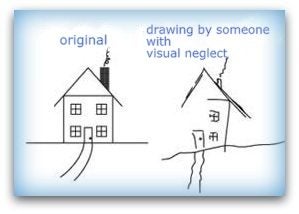
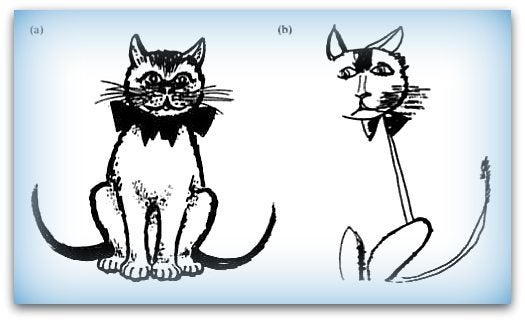
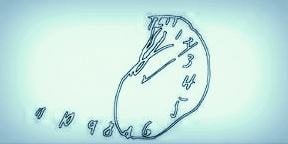
These are drawings of a house, cat and of a clock as seen by a person with neglect.
In addition, neglect can be determined with an observation list like the Catherine Bergego list. This list examines possibly typically 'neglect behavior' in activities in daily life.
Neglect may involve all sorts of problems in everyday life.
- A person 'forgets' to eat the food that is on one side of the plate
- During shaving only one half of the face is shaved
- Only half of the face is processed with makeup
- Difficulty finding stuff in the bathroom or the bedroom on one side
Neglect can give problems in finding the way or in spatial perception
- People seem to run into things on the affected side (obstacles, doorframe), because that side is not observed
- Driving a car with neglect can be dangerous because people or objects on the affected side are not observed
- One can get lost because rooms on the affected (usual left ) side are passed by, without even having seen them
- People on the affected (usual left) side are 'ignored', not because of unwillingness, but because they are not observed
Neglect of the own body:
- In extreme cases, the patient does not recognize his own cripple arm or leg He feels that there is a 'strange' leg in bed.
- A person may forget to take his right / left leg out of bed or from the wheelchair
- When a person is sitting on a chair or lying in bed, the cripple arm is hanging down. By this, injuries easily occur and they are also less noticed by the neglect.
How to deal with neglect?
Make physical contact with the affected body part, for example by making it 'visible' and active. Place both arms of the patient on the table or approach while talking, to avoid startling the person from that side. Do realize that it is not unwillingness.
If someone's body is paralyzed on one side, while one half of the visual field is ignored, you know that the person with that kind of injury does not perceive his affected side or perceive less. He/she is not 'aware off' the affected side. This is the so-called 'neglect'.
Accidents may happen easily with this combination of symptoms (but also even without paralysis!). An arm may get caught in the wheelchair wheels, also 'unnoticed'. In addition, stuff may get 'lost': glasses or a cup of coffee placed in the neglected field of view, will be difficult or impossible to find.
Pay attention to where you sit when you want to talk to a patient with neglect. Also make sure that the person can see the door from his bed and does not face a blank wall.
Hemianopia or hemianopsia (visual neglect)
With damage in the brain, for example in the back of the head, the field of view may change. Hemianopia is a decreased vision or blindness (anopsia) in half of the vision field or one or both eyes, usually on one side of the vertical axis.
The most common causes of this damage are: stroke, brain tumor, and trauma.
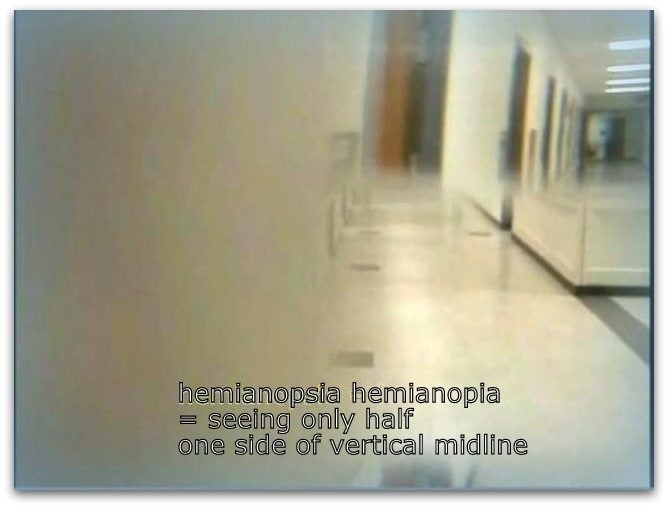
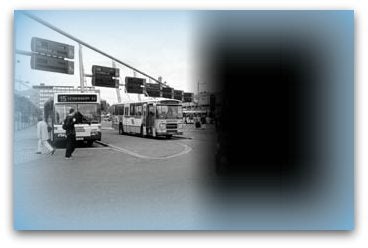
A person with hemianopia may teach himself some handy tricks in order to get a complete picture of everything. He can teach himself to turn the eyes and head so he gets a complete picture of the environment. However, this is not possible in all activities; sometimes help of a person directly involved is the only solution.
Often the term hemianopia is used as a collective name for all types of half-sided loss of field of vision. When a quarter of the field of vision is lost, it is referred quadrantanopia.
Some tips in case of hemianopia
Make sure that things are in a fixed position so that the person knows where to look (alarm clock, towels, plates, cutlery).
Learn a search behavior. Teach the person to always search a room or object from the left to the right and from top to bottom and back.
Have the person scan the entire door jamb with the eyes, so he can estimate how wide it is before walking through the door.
Learn a fixed sequence of bathing: Always start with the affected side and finish with the healthy side. It is wise after bathing and dressing to make sure nothing is forgotten. Start with the affected side and finish with the healthy side.
Resources Utrecht University, Tanja Nijboer, Krista Huisman, Anne Visser-Meily, Anja Eijsackers, Support of Research at Brink's Hoogstraat rehabilitation, Hersenstichting.nl, Sweet Mountain Hospital neurology, JBM Kuks, J. W. Pike, H.J.G.H. Oosterhuis. Clinical Neurology 15th Edition, Bohn Stafleu Of Loghum, Wood, 2003, ISBN 90-313-4028-6,hersenletsel-uitleg.nl